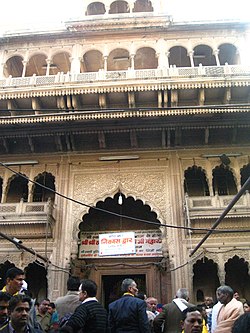| Banke Bihari Temple | |
|---|---|
Kunj Bihari Temple | |
 Banke Bihari, a combined form of Radha Krishna at Banke-Bihari temple, Vrindavan | |
| Religion | |
| Affiliation | Hinduism |
| District | Mathura |
| Deity | Banke Bihari (Radha and Krishna) |
| Festivals | Janmashtami, Radhashtami, Holi, Sharad Purnima, Karthik Purnima |
| Location | |
| Location | Vrindavan |
| State | Uttar Pradesh |
| Country | India |
Location in Uttar Pradesh | |
| Coordinates | 27°34′47″N77°41′26″E / 27.57976°N 77.69051°E |
| Architecture | |
| Type | Rajasthani |
| Completed | 1862 [1] |
| Elevation | 169.77 m (557 ft) |
| Website | |
| bankeybihari bihariji | |
| Part of a series on |
| Vaishnavism |
|---|
 |
Banke Bihari Temple is a Hindu temple situated in the town of Vrindavan, Mathura district of Uttar Pradesh, India. The temple is dedicated to Banke Bihari who is believed to be the combined form of Radha and Krishna. Banke Bihari was originally worshipped at Nidhivan, Vrindavan. Later, when Banke Bihari temple was constructed around 1864, the icon of Banke Bihari was moved to its present temple. [2] [3]
Contents
In the Banke Bihari temple, the icon of Radha Krishna's united form stands in the Tribhanga posture. Swami Haridas originally worshipped this murti under the name of Kunj Bihari, which means the one who enjoys in the groves or Kunj of Vrindavan. [4]






